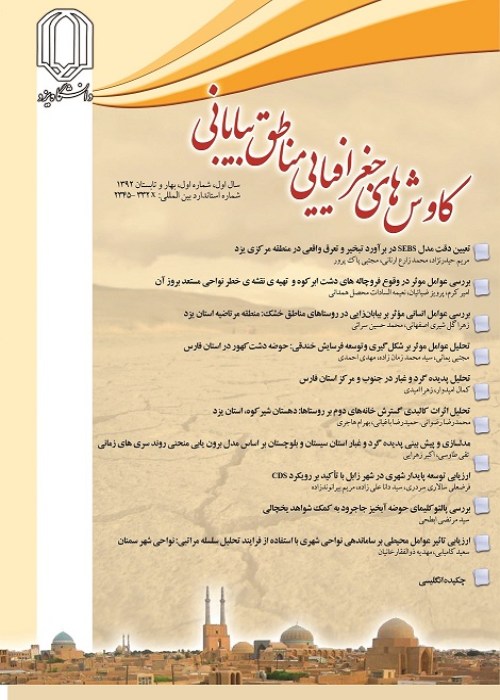Dynamic Evaluation of Barchans in Band-e-Rig Kashan in the Period 2013 to 2019
Wind erosion and the formation of sand dunes are common phenomena in many arid regions around the world. More than 100 types of sand dunes have been classified by geomorphologists based on shape and size criteria (Lancaster, 1995). One of the most common and simple types of sand dunes, in areas with one-way winds throughout the year and the inability of sand to cover the entire surface of the area, is the crescent-shaped hills called Barchan (Suerman et al., 2000). Barchan is a single crescent-shaped hill that forms a cohesive and solid surface on the ground, such as a ridge, pediment, or desert pavement (Cook et al. 1993).
To do this research, 11 barchans from the southwest of Mariana Rig were selected, 30 km from Aranbidgol city. Using the images of the Google Earth software archive, the determination of the area of the study area was carried out and then, with field observations, the measurements of the barchans were made. The Google Earth software was used to check and record the amount of displaced barchans over time periods between 2013 and 2019. Also, by using the bar method in 2013 and estimating the amount of displacement relative to the fixed bars in 2019, the measurement of the speed of the barchans along with parameters of area, volume, height, density, periodic variation and length to width ratio Was evaluated and analyzed. Also, in order to investigate the role of wind in the movement of Aeolian sand and Barchans, the 31-year statistics of Kashan meteorological station were used. For this purpose, the desired data was entered in Wrplot 5.0 software and finally the annual flower of Kashan station was drawn. The wind of Kashan station indicates the prevailing northeast wind in this region.
The maximum total total displacement during the years 2019-2013 in Barchan No. 9 has been calculated at 68 meters with an average annual displacement rate of 8.5 per year. The minimum total total displacement during the years 2019-2013 has been calculated in Barchan No. 7 at the rate of 43.9 meters with an average annual rate of 5.5 meters. The rate of 103.5 percent compared to the percentage of negative changes of 93.34, shows the net rate of change of 10.16 percent positive. In other words, during the years 2013 to 2019, the rate of expansion of sand dunes in the study area shows an increasing trend, and on the other hand, the sand zone created during the years 2013 to 2019 has had a lot of area fluctuations. According to the reliability index, the higher the annual displacement of the Barchans, the more unfavorable the reliability index will be. According to Table 8, most of the brooches in the study area with a displacement between 6 to 9 meters are in the category of instability and only one brook is in the category of very low reliability.
The results show that the average displacement speed of selected Barchans is 7.6 meters per year with a range of changes between 5.5 to 8.5 meters per year and the displacement rate in three time periods indicates an increase in displacement in the period 2019-2017 compared to two The period is before that. Pearson correlation test was used to investigate the relationship between volume and cell movement. Pearson correlation between the two variables is calculated to be -19.19 and sig is equal to 0.558, which indicates a very weak negative correlation between the volume and the amount of movement of the selected braces. It is somewhat reduced and this correlation is not completely linear. However, the study of the relationship between length to width ratio with the amount of cell movement shows that by increasing and decreasing the length to width ratio from a numerical value of one, the amount of cell movement decreases significantly. In other words, the maximum displacement of selected Barchans will be when there is a proportion in the ratio of length and width of Barchans. Looking at the periods under study, it can be seen that during the years 2019-2013, when the length-to-width ratio is around one, the highest amount of Barchans movement has occurred. Precipitation also plays a very important role in the rate of cell displacement. The annual precipitation data of Kashan station during the years 2019-2013 indicate the direct effect of rainfall on the displacement of the Barchans, so that in the years with increasing rainfall, the movement of the studied Barchans has increased and in the years with decreasing rainfall, the movement of the Barchans can be significantly Attention has been reduced. The reliability index also indicates the instability of the studied Barchans, so that according to the calculated amount of movement of selected Barchans, this index indicates the average movement of regional Barchans compared to the amount of movement recorded in previous studies in Iran and the world.
- حق عضویت دریافتی صرف حمایت از نشریات عضو و نگهداری، تکمیل و توسعه مگیران میشود.
- پرداخت حق اشتراک و دانلود مقالات اجازه بازنشر آن در سایر رسانههای چاپی و دیجیتال را به کاربر نمیدهد.


